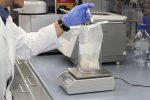Everyone understands the importance of a robust food safety program. It should ensure the safety of the product and environment, backed by solid, traceable data. The food industry is vast, stretching from the farm all the way to our plates, and includes a diverse array of foods and drinks. Different segments of this industry have specific needs, whether it’s unique spoilage tests or specialized predictions based on distinct data. Unfortunately, current services haven’t delivered a trustworthy solution for these needs.
Rodrigo Malig is the Chief Product Officer at TAAG Genetics. He oversees both the artificial intelligence and molecular diagnostic teams. In this column, Rodrigo discusses the crucial roles of AI and molecular testing in crafting a reliable, tailored solution for food safety.
What are common deficiencies in current food safety and quality programs?
Malig: Common shortcomings in Food Safety and Quality programs (and frustrations for hardworking FSQA professionals) include:
Lack of Customization: Many programs don’t adapt or customize to specific industry needs.
Routine Sampling Issues: Environmental sampling is often random, lacking intelligent risk-based criteria. There’s also an insufficient adaptive process after each sampling cycle.

Testing Targets: The targets for environmental and finished product testing are often insufficient. For instance, industries need specific tests for spoilage microorganisms, but many don’t have access to these tests and rely instead on general aerobic plate counts, and yeast and mold.
LIMS (Laboratory Information Management System) Limitations: These systems often don’t offer accurate digitized mapping, customization or ability to adapt, leading them to inaccurately represent a facility or its changing needs.
Outdated Methods: Some programs still rely on outdated technologies and methods. Let’s take plate counts for example. There’s a focus on mere quantitative results without the specificity of what those organisms are. This prevents facilities from taking precise corrective and preventive actions. Additionally, we all know plate counts can be time consuming with long incubation times, have limited sensitivity, lack genetic information, require manual labor (thereby creating additional risk for contamination) and increase overall costs. It is essential to determine when plate counts need additional support or substitution, such as with PCR (Polymerase Chain Reaction).
Comparison to FDA Standards: Many confirmation methods are inferior compared to the FDA’s Whole Genome Sequencing.
PCR Kit Issues: When using PCR, many kits test for only a single microorganism. This limitation requires multiple tests to be run, leading to increased turnaround times and costs.
Traceability Concerns: A significant deficiency is the lack of traceability in many programs, requiring additional documentation to be performed on paper.
Incomplete data and analysis: Antiquated data management systems result in insufficient data collection and digitization. Many in the industry still manually write on paper or use Excel spreadsheets, which makes keeping track of data, trending it and analyzing it more difficult and time consuming.
Reactive and not predictive: Because of the deficiencies detailed above, food safety programs become reactive and insufficient to address risk.
How can we improve current food safety and quality programs?
Malig: An improved food safety and quality program must become predictive (and not reactive), by embracing and implementing technology featuring customization, molecular testing and AI. Below is a basic checklist for food companies to follow:

Customized Software & Testing: Utilize software and tests tailored to your unique requirements.
Advanced Environmental Sampling: Embrace sampling that’s customized, risk-based, predictive and adaptive. Employ digitization and AI to efficiently map, record, analyze and predict sampling schemes. This system should also adapt after each cycle and accommodate changes in the environment, equipment and processes.
Molecular Testing: Polymerase Chain Reaction (PCR) testing is a molecular biology technique with several advantages, including:
- Sensitivity: PCR is highly sensitive and can detect very small amounts of genetic material (DNA or RNA) in a sample. This makes it effective for detection even when the pathogen is present in low concentrations.
- Specificity: PCR is highly specific, meaning it can accurately identify and differentiate between different microorganisms or genetic variants. This specificity reduces the likelihood of false-positive results.
- Speed: PCR can provide results relatively quickly, often within a few hours, depending on the type of PCR used (e.g., real-time PCR or RT-PCR). This rapid turnaround time is crucial for time sensitive decisions in the food industry.
- Cost: PCR can be cost efficient, especially with multiplex PCR kits that detect multiple pathogens in a single reaction, which essentially cuts time, labor, use of lab equipment and space, and overall cost.
Industry-Specific Microorganism Testing: Ensure you’re testing for microorganisms relevant to your industry, processes and products. This is especially crucial if your products are susceptible to spoilage by specific microorganisms.
Adaptive LIMS: Your Laboratory Information Management System (LIMS) should be both customizable and adaptive. It should digitally represent your facility with accuracy and adapt to any changes or needs.
Dynamic Microbiological Programs: Move away from reactive and repetitive testing schemes. Most current microbiological programs tend to test the same samples repeatedly. With the help of AI algorithms, we can now implement preventive and risk-based microbiological programs.
This real-life case study illustrates how a Fortune 100 Company implemented the solutions above to improve their food safety and quality program.


























